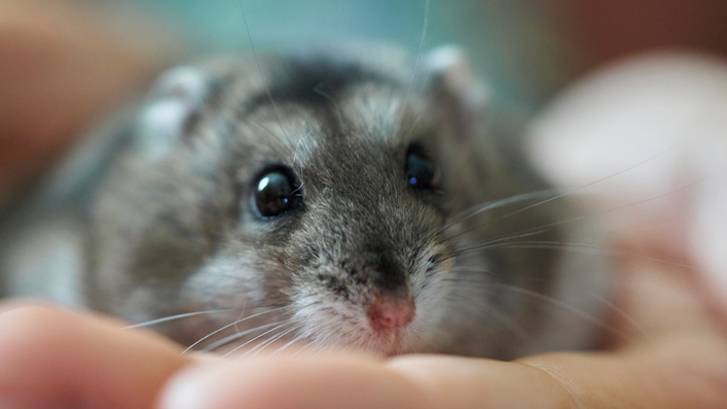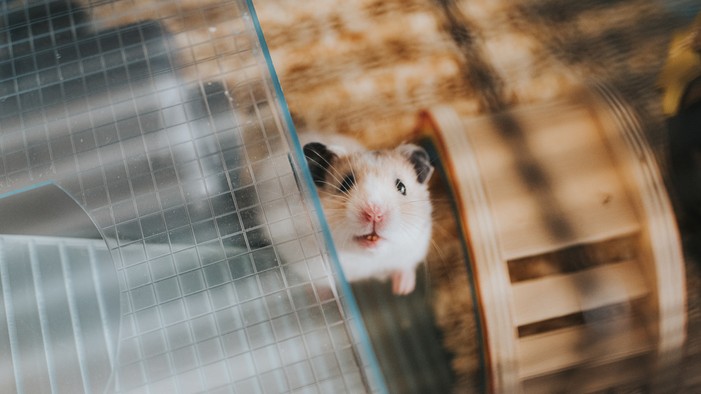How to bond with your hamster
Build affection between you and your rodent buddy with our handy guide

Although you may not think of small pets as particularly cuddly or affectionate, learning how to bond with your hamster can lead to a more rewarding relationship than you might have thought possible.
Probably the most important thing you will need when learning to bond with your hamster is patience and lots of it. It’s hardly a surprise that hamsters and other small pets are naturally nervous of humans, considering the size difference! In this guide, we’ll be answering some common questions you might have, including how to handle and play with your fur friend.
If you’re new to hamster ownership, you may also want to know how to check for signs of a stressed hamster, and find out how provide them with the optimal living environment to meet their needs. Our guides to quality hamster toys and top-rated hamster cages will ensure your little friend has everything they need to thrive.
How long does it take for a hamster to bond with you?
Small animals like hamsters are naturally shy and cautious, so don’t expect an instant bond to form the moment you bring your new hamster home. Be prepared to take baby steps so as not to scare or overwhelm them, letting them settle in gently and slowly.
When you bring your hamster home, expect it to be a couple of weeks - at least - for a full bond to form. Don’t rush to get them outside of their cage straightaway, give them a couple of days to settle in before interacting with them at all.

What are the ways to bond with a hamster?
Slow and steady wins the race when it comes to hamster bonding. First of all, give them some time to get used to your voice, your presence and even your scent. It might feel a bit silly, but talk to them in their cage - using a soft and gentle voice.
Once they seem to have settled into their new home reasonably well, you can start to take the next step. Open the cage door and very gently place your hand inside the cage - being careful not to make any sudden movements or loud noises. Repeat this a few times to get your hamster used to your smell and your presence.
The next thing you can try is including a small piece of food in your hand when you place it in the cage. With any luck, your curious hamster will come and sniff out the treat you’ve presented, and if they feel secure and safe they will take this. Try stroking your hamster gently while they are eating, and again repeat this a few times before you attempt to pick them up or remove them from the cage.
How to hold a hamster
Hamsters have a reputation for being tricky to hold since they’re small, wriggly and unpredictable. While that’s true, once you have built up a good bond with your hamster, you should find that they are easier to manage.
You want your hamster to feel safe and secure when you’re holding them, which largely comes from how you approach the task. You must never take your hamster by surprise - so make sure they’re looking towards you before you attempt to hold them.
Approach your hamster calmly and gently, but confidently so that they know you’re not likely to drop them or hurt them. Using two hands is preferable, creating a scoop underneath their bottom. It’s best if you pick up the hamster so it is facing you, making it less likely that the hamster will jump off as they’ll be able to see what’s going on. You can also bring it towards your body to create a sense of security.
Avoid holding your hamster in a high position where they might jump and injure themselves.

How to show affection to your hamster
Just like most animals, hamsters are receptive to affection. You can show your rodent friend that you love them in myriad ways.
As well as gently stroking their fur and ears, you can also give them treats that you know that they’ll love (though not too many). Holding them regularly and playing with them also shows them that they are part of your life. Introducing hamster toys to both their cage and any time outside of it is a good way to show affection too.
How often should I hold my hamster?
Hamsters need plenty of stimulation, but they also like routine. Where possible, you should be aiming to hold and play with your hamster every day.
Holding them at roughly the same time every day is also a good idea, and you should be mindful not to disturb them when they are sleeping, eating, drinking or going to the bathroom. You may have heard that hamsters are nocturnal, but it’s fairer to say that they are crepuscular, meaning they are most active at dawn and dusk. Try to time your interactions with them when they are at their most receptive to being handled for the best results.
How to get your hamster to come out of their cage
You may find that you have a particularly shy hamster, especially when they’re a new addition to your household or are so comfortable that they don’t want to leave their cage! Forcing them to come out of their cage is never a good idea, but there are things you can do to encourage them to want to come out.
For example, you can place treats near to the door of the cage, leaving the door open with supervision and watching to see if they gently come out. You can also place some hamster toys near to the cage door and watch to see if they come to investigate.
Never rush your hamster, and give them plenty of time to get used to your voice and smell. Most hamsters will eventually come to bond with their owners and be only too pleased for some time outside of their cage.
Lastly, if you have any other pets - such as cats or dogs - make sure they’re out of the room when you want to get your hamster out. Even if you trust your larger pets, your hamster is likely to be scared or anxious around bigger animals.

How to play with your hamster
As well as a good range of official hamster toys that you can buy, hamsters are easily pleased with more basic run-of-the-mill household goods.
A common one that appeals to hamsters is the tubes you find inside toilet roll and kitchen roll, and even wrapping paper. Introducing these cardboard tubes to your hamster is a good way to play with them.
Letting your hamster run from one hand to the other in a stepping motion is a classic play tactic that they will usually enjoy, too. You may see hamster balls for sale - clear plastic balls which give your hamster the opportunity to run around the house somewhat unsupervised. The consensus these days is that these toys shouldn’t be used, as they can cause stress and danger to your hamster - an exercise pen or or larger cage should be considered for playtime instead.
How do you know if your hamster has bonded with you?
It might not be as overwhelmingly obvious as with pets like cats and dogs, but hamsters definitely do bond their owners and display behaviors which demonstrate that.
The biggest indicator is that the hamster is not tense with you and is happy to be picked up and handled. Other clues are perhaps a little more subtle, such as them being relaxed enough to display relaxed activities like yawning and stretching. You may even find that your hamster bonds so closely with you that they will fall asleep on you - then you’ll know that your hamster has become very attached to you indeed.
PetsRadar Newsletter
Get the best advice, tips and top tech for your beloved Pets
Amy Davies is a freelance writer and photographer with over 15 years experience. She has a degree in journalism from Cardiff University and has written about a huge variety of topics over the years. These days she mostly specialises in technology and pets, writing across a number of different titles including TechRadar, Stuff, Expert Reviews, T3, Digital Camera World, and of course PetsRadar. She lives in Cardiff with her dog, Lola, a rescue miniature dachshund.

